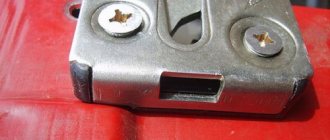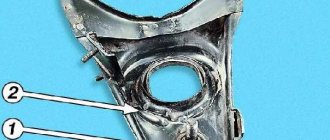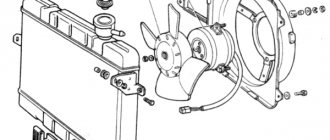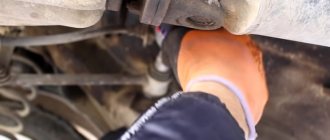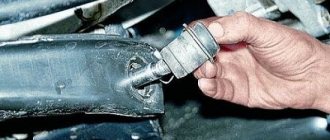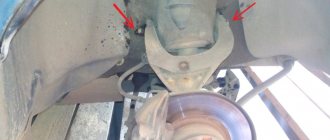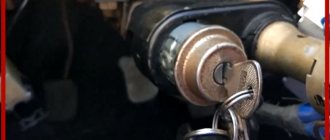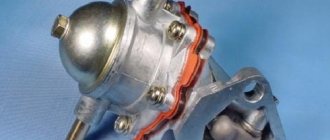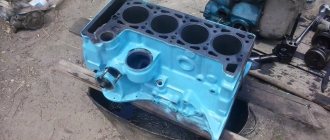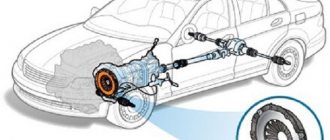The models differ significantly from each other
“Five” and “Seven”: what distinctive features do these two models of domestic cars have? Why do experienced car enthusiasts today increasingly prefer products from the domestic automotive industry? What should you know when choosing between VAZ 2105 and VAZ 2107? Let's try to figure it out.
The good old Zhiguli has established itself as a good and reliable brand, the price/quality ratio of which forces the buyer to choose this particular domestic car. And yet, what is the difference between the VAZ 2105 and the VAZ 2107, if the new “seven” exceeds the “five” in price? Which model to choose: 2105 or VAZ 2107?
At the peak of their popularity, these two models had significant differences. Until 1988, the VAZ 2107 was equipped with such devices.
- Brake pad wear sensors.
- Crankshaft position sensor.
- Headlight washer.
- Relay-breaker for the parking (hand) brake warning lamp.
- Generator G-222.
- Contactless transistor ignition system.
- Oil pressure sensor.
- General technical diagnostic block.
In the 90s, manufacturers replaced or removed all these components, thereby reducing the cost of the VAZ 2107. But “fives” and “sevens” are still produced today, having great popularity in the domestic market, and they differ only slightly. Which is better: “five” or “seven”? There is no clear answer. It is generally accepted that the VAZ 2107 is an improved model of the “five”, but is this really so?
External differences between models
- The “Seven” has a chrome radiator grille, while in the VAZ 2105 it is made of black plastic. For practical drivers, the second option will seem the best, since if you frequently use the services of a car wash, the grille of the “Seven” will very quickly take on a not the most presentable appearance, since it is susceptible to corrosion and delamination of the chrome coating.
- The “Seven” has a wider “range” of instruments: a tachometer, an econometer, a center console with an output for a radio and a clock. The “Five” can only boast a socket for the radio, which is located under the front panel, and access to it is a little difficult.
- The trunk lid of the “five” has indentations, while on the “seven” it is absolutely straight and smooth.
- The structure of the taillights is different.
- The front seats are equipped with comfortable headrests, which is typical for the “Seven”.
Which one to choose?
Based on the above, the VAZ-2105 is suitable for those who choose a car for short trips and rarely travel outside their region. An ideal option for rural residents, summer residents, pensioners, students, novice drivers, when there is no point in overpaying for comfort.
The VAZ-2107 reveals its advantages in practice on a long journey. Suitable for traveling with a small group and family, as well as business and work trips. The five-speed transmission contributes to maximum speed and fuel economy on the highway. Often used as an inexpensive taxi in the provinces and on the periphery of our country.
These models have great potential for tuning, and are often participants in amateur races and sports competitions, for example, drifting and street racing, but it would seem that the “classics” have long since sunk into oblivion...
Conclusion - cars 2107 and 2105 have a significant difference, only in the design of the engine, the injection engine is more dynamic and economical than the carburetor engine. The 2107 has a more informative dashboard and is a little more comfortable in the cabin. The cost of 2107 is slightly more expensive, the car looks a little more solid and modern.
Auto and motorcycleComment
Technical characteristics of the “five” and “seven”
- The VAZ 2107 has a slightly different ventilation system (cold air deflector): air is taken in directly, not through the heater radiator. In the VAZ 2105, ventilation is carried out through the “stove” radiator.
- Some models of “fives” and “sevens” of different years of production have differences in engine power: 77 horsepower for the 2107 and 69 “horses” for the “five”.
- The piston stroke and cylinder size are also different: 66x79 in the “five” and 80x76 in the “seven”.
- Acceleration time to 100 km/h. The VAZ 2107 accelerates from a standstill in 15 seconds, and the 2105 in 18 seconds.
This is probably where the differences end; then we can only talk about the similarities:
- both models have rear-wheel drive;
- body type and number of seats, permissible additional trailer weight and braking distance, gearbox and steering mechanism, fuel tank and suspension, battery, generator and starter are absolutely identical for both models.
Appearance of headlights of models
VAZ is somewhat superior to other domestic car brands: their models have always been distinguished by the reliability and wear resistance of components, the relative cheapness of parts, spacious interior, and height (which is especially important for domestic off-road use).
Injection system
VAZ 2107 cars have recently been produced with an injection engine with a power of 73 and 77 l/s, with a displacement of 1.6 liters. The injection version has an electrically driven fuel pump and a main electronic engine control unit, which is responsible for the operation of many vehicle systems. Fuel consumption has decreased significantly compared to the carburetor version.
Both car models are equipped with a manual transmission system, with four or five gears, depending on the modification. They have a single-disc clutch type and rear-wheel drive with a cardan drive. The brake system of 2105 and 2107 is identical, the rear wheel brakes are drum type, the front wheels are disc brakes. Both cars are equipped with standard 13-inch wheels.
VAZ-2104 / 2105 / 2107 what is the difference?
#1 Stan
- Users'
- 3,903 messages
- Gender: Man
Post edited by Stan: 06 December 2009 - 19:57
- Top
- Forum Rules
#2 benali
- Gender: Man
- City: v16
Post edited by benali: 06 December 2009 - 11:42
- Top
- Forum Rules
#3 Stan
- Gender: Man
Five is a cheap sedan with a crap rusting body
- Top
- Forum Rules
#4 benali
- Gender: Man
- City: v16
- -1
- Top
- Forum Rules
#5 Wild
- Gender: Man
- City: Volgodonsk
- Top
- Forum Rules
#6 Wild
- Gender: Man
- City: Volgodonsk
- Top
- Forum Rules
#7 serg_ro
- Gender: Man
- Top
- Forum Rules
#8 —Shark—
- Gender: Man
I don’t know how things are now. But the 7ka was made for export, therefore the quality of the car is better than the 5ka. From the beginning of production, the 5ka was made of bad metal and therefore the body began to quickly rust and all sorts of other things. I don’t know how things are now with the new ones. But with It looks like the new 7s have become worse than those released before (IMHO)
the 7 has a better interior and I heard that the metal on them was more expensive, all the 5's that I saw are rusty, after 3 years they start to rot, the 4's are the same 5's in quality, only the body shape is station wagon
Gentlemen, you are so big, but you believe in fairy tales. Open the spare parts catalog on 04-05-07. The bodywork is the same, with the exception of parts that differ in shape. The metal and paint are absolutely identical. The difference: the four is a station wagon, the seven is a different “face”, a more expensive interior, the five is a cheaper interior (a different front panel, there is no tachometer, a different layout of the heater pipes, before there were different seats, cheaper ones, now they put seven seats for the purpose of unification, rear sofa on the five without armrest). There are no other differences! The best metal or the best color is a myth. Everything is assembled on one conveyor belt from the same spare parts.
And seven and five and four come from the same assembly line. The seven has better geometry. And the metal on them is the same.
Post edited by —Shark—: 06 December 2009 — 14:30
- 2
- Top
- Forum Rules
VAZ 2106
Compared to the top five, this model has more positive responses on ad sites. This car has five seats and four doors, and is also rear-wheel drive. The car began production 4 years earlier than the five. The car was developed based on the 1972 FIAT 124 Speciale. After some time, this car became the most prestigious after the Volga. 8 modifications of this car were created, including an export version for countries with left-hand traffic.
By the standards of the times of the Soviet Union, this car had a powerful engine of 80 horsepower, the displacement of which was 1.6 liters. The model is often compared with the VAZ 2103, against which it has a slightly different design: a modified radiator lining, different bumpers with polyurethane inserts. The model also illuminates the license plate.
At that time, the car was really good: a high speed of 150 kilometers per hour, comfortable seats, a dashboard with a tachometer and good noise reduction. It’s also very nice to look at the interior of the six of that time. It looks great after renovation and will still look great now.
The car costs a little more than a fiver. And although the minimum price starts from 30 thousand, most offers of used sixes range around 80-120 thousand. Moreover, this price is for cars with fairly low mileage. That is, the offer is definitely profitable.
On one of the ad sites, a 1998 six with a mileage of 119 thousand kilometers in good condition is sold for 135 thousand.
One of the characteristic advantages of the car is its resistance to severe frosts. So, one of the car owners writes that at a temperature of -38 the car started very easily. Users also liked the car heating system. After just 10 minutes in winter, you could ride in just a T-shirt without feeling cold.
Another positive side of the car is its cross-country ability. The car handled well even on rural roads for a non-SUV vehicle.
The owners of the car paid special attention to its maintainability. The machine is unpretentious in maintenance, despite its age, spare parts are very cheap, and repairs can be done independently
Among the shortcomings is outdated design. This car clearly cannot be used to show off status. But from a practical point of view, it is a very good option.
Selection of carburetor for VAZ 2101-2107
An engine is a complex mechanism that is sensitive to the quality of the prepared fuel-air mixture. The air-to-gasoline ratio greatly affects speed characteristics. The more air, the worse the car accelerates and the fuel consumption increases. An excess of the latter leads to the same result. The resulting soot from unburned gasoline covers all engine parts, worsening heat transfer and causing the engine to “boil.” Therefore, the carburetor is selected according to the engine size:
- "Ozone 2105" is intended for engines with a volume of 1200, 1300 cm 3.
- "Ozone 2107" - 1500 and 1600 cm 3.
- "Solex 21053" - 1500, 1600 cm 3.
- "Solex 21073" - 1600, 1700 cm 3.
But it’s better to entrust its selection and configuration to a specialist because it will be easier, faster and cheaper than doing everything yourself.
VAZ-2105 and 2107 are largely identical cars, differing from each other in body parts, an improved instrument panel and an improved interior.
How to repair a carburetor yourself
Repair work on the VAZ 2106/2107 carburetor involves removing and disassembling the mechanism. In this case, the repair includes all two stages:
- Washing (cleaning, blowing) elements from carbon deposits and adhering dirt.
Replacement of worn or failed parts.
Before carrying out any actions with the unit, you must firmly make sure that the carburetor is faulty. Often, incorrect operation of other systems can affect the performance of the carburetor mechanism.
The carburetor is located under the hood, above the engine.
Troubleshooting
DAAZ carburetors of any modification are designed to operate stably regardless of operating modes. However, it is precisely the change of modes (for example, starting “cold” or accelerating when overtaking) that can show the first problems in the operation of the device. The carburetor is clearly faulty if:
- at idle there are failures in engine operation;
while driving, a time interval is noticed between pressing the gas pedal and accelerating the car;
jerks in engine operation at high speeds;
a series of jerks when overtaking;
Gasoline consumption has increased significantly;
Difficulty starting the engine after long periods of parking.
Each of these signs, as well as their combination, indicates that there is a problem with the carburetor and repairs or adjustments are necessary.
Overflows
One of the most common problems with carburetor engines is the so-called overflow. An excessive amount of fuel is supplied inside the device, and for some reason the check valve is not able to drain excess gasoline back into the tank. Therefore, under the carburetor and on it itself, the driver may notice drops of fuel.
Shoots
This concept is inextricably linked with transfusion. If the carburetor begins to shoot (or sneeze) - that is, jerk sharply while driving and even ignite - there is a fuel leak. The mechanism needs to be flushed.
Gasoline is not supplied
The problem may lie either in the carburetor itself (the jets are seriously clogged or the pump is broken) or in the supply hoses. It is recommended to blow out the fuel supply pipe and test the operation of the fuel pump. If they function normally, you will have to remove the carburetor and wash it.
The secondary internal combustion chamber does not work
Failure to operate PIC No. 2 will immediately affect the vehicle’s dynamism: it loses almost 50% of its original speed characteristics. The problem is that the throttle valve is sticking, which regulates the flow of fuel into the chamber cavity. You will have to disassemble the mechanism and replace the damper with a new one.
What is the difference between the VAZ 2105 and the VAZ 2107
- What is the difference between the VAZ 2105 and the VAZ 2107
- How much does a VAZ-2107 cost?
- Car VAZ-21063: characteristics, reviews
There are not very many differences between the five (VAZ-2105) and the seven (VAZ-2107). Looking at these two cars, we can say that they are the same model. But no, there are a lot of differences that will become noticeable gradually. The Seven is a luxury version of the outdated Five. It has many improvements that drivers are not even aware of. Five is a cross between the VAZ-2101 and VAZ-2107. In terms of convenience, it’s better than a penny, but a little worse than a seven.
Let's sum it up
Those who have had a driver's license for a long time know about the differences between the VAZ 2107 and 2105. But beginners often have doubts about the choice, since distinguishing one car from another is problematic. And there is no particular difference in technical and functional equipment. The main differences relate to the external features of the “seven” and its comfort in terms of landing and control.
The VAZ manufacturer itself at one time considered the differences between the standard and luxury models significant. But now they have almost leveled out, both models are sold as budget ones.
VAZ 07 and 05 sedans are among the cheapest cars on the Russian secondary market, but potential buyers should understand that most of these models are many years old. This means that the quality of assembly and functional elements does not meet modern standards; many parts are worn out and require replacement. No matter which of the presented cars you choose, you cannot hope for a 100% safe and comfortable ride.
If desired, you can do tuning and update the car outside and inside. But this will require additional cash injections, and considerable ones. In this case, a more acceptable option is to purchase a modern car in the appropriate price category.
Engine
This is an important part of any car. But due to the peculiarities of AvtoVAZ’s production policy, this is not a detail by which one can understand how the VAZ-2105 differs from the VAZ-2107.
On the VAZ-2105, in addition to engines 2101 and 2103, a model with the index 2105 was installed. It was created by making several changes to the design of 21011:
- Timing belt drive instead of chain drive.
- Cast aluminum cylinder head cover.
- Recesses for valves to prevent damage if the belt breaks.
These measures have led to a significant reduction in noise from engine operation and an increase in service life.
The VAZ-2107 was equipped with the following engines: 2103, 2105 and 2106 with a volume of 1500, 1300 and 1600 cm 3, respectively. There were also modifications for the needs of the traffic police, the Ministry of Internal Affairs and the KGB. They used a VAZ-4132 rotary piston engine with a volume of 1.6 liters and a power of 140 hp. With.
Wheel rim parameters for model 2108
Like the 2107, the 2108 featured 13-inch forgings from the manufacturer. On the Lada Nine (VAZ 2109) with five doors, R13 wheel products were also used.
Tire parameters: 165/70/R13, 175/70/R13.
However, unlike the seven, the eight used discs with the following parameters:
- width 5J;
- departure ET40;
- drilling 4×98;
- diameter of the central hole is 58.6 mm.
Also, depending on the modification, wheels with sets of tires could be used on the eight and nine:
Differences in the cabin
Before looking under the hood of these cars, let's first go through the interior, there are more differences here. “Seven” is a more modern car, so even Soviet designers were puzzled by the high-quality equipment of the torpedo. On the instrument panel of the VAZ-2107 you can find the following options that the “five” does not have:
- Tachometer.
- Econometer.
- Availability of a special console designed to connect additional equipment.
Model 2105 only boasts an input for audio devices. Moreover, the previous generation of Soviet engineers “did their best” by hiding it so inconveniently that getting to it right away is not so easy.
Another characteristic feature of the “seven” is the specific design of the seats. On this model, AvtoVAZ has already used sofas with special headrests. You won’t find anything like this on the “five”, unless the car owner himself has replaced the interior with the installation of new seats.
Tuning
The VAZ 2107, along with other “classic” models, is one of the most tuned Russian-made cars. Its cheapness, on the one hand, and outdated design, on the other, force many owners over time to make efforts to modernize the car.
For example, installing hydraulic compensators on the engine results in a noticeable reduction in engine noise and an increase in timing belt life. We also offer ready-made kits for replacing rear drum brakes with disc brakes.
Due to the large volume of classic cars in use, manufacturers of spare parts offer a lot of finished industrial products to improve consumer properties, and even conveyor suppliers offer “improved” products to replace their own components (for example, a heater motor on bushings from the factory - change to a motor with bearings). The “classics” segment probably has the widest selection of spare parts that differ from the factory equipment.
